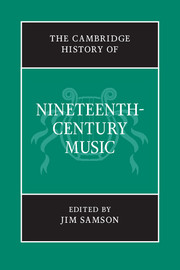Book contents
- Frontmatter
- Part One 1800–1850
- 1 The musical work and nineteenth-century history
- 2 Music And the rise of aesthetics
- 3 The profession of music
- 4 The opera industry
- 5 The construction of Beethoven
- 6 Music and the poetic
- 7 The invention of tradition
- 8 Choral music
- 9 The consumption of music
- 10 The great composer
- Part Two 1850–1900
- Chronology
- Institutions
- Personalia
- Index
- References
2 - Music And the rise of aesthetics
from Part One - 1800–1850
Published online by Cambridge University Press: 28 March 2008
- Frontmatter
- Part One 1800–1850
- 1 The musical work and nineteenth-century history
- 2 Music And the rise of aesthetics
- 3 The profession of music
- 4 The opera industry
- 5 The construction of Beethoven
- 6 Music and the poetic
- 7 The invention of tradition
- 8 Choral music
- 9 The consumption of music
- 10 The great composer
- Part Two 1850–1900
- Chronology
- Institutions
- Personalia
- Index
- References
Summary
Music, rhetoric and representation
The development of the new subject of aesthetics from the middle of the eighteenth century onwards and the changes in the status of music associated with the rise of ‘Romanticism’ form a constellation which has profoundly affected many aspects of modern thought. Perhaps the most striking illustration of this constellation is the quite widespread acceptance, between the later part of the eighteenth and the middle of the nineteenth centuries in Europe, of the Romantic idea that music might be able to say more about philosophy than philosophy can say about music. Just how strange such an idea would have been during much of the eighteenth century can be gauged by the fact that in his Critique of Judgement of 1790 Immanuel Kant, who was in other respects decisive for the development of Romanticism, still saw music as a lowly art form, the effects of which were analogous to a person in society taking out a perfumed handkerchief whose smell could not be avoided. The wider significance of the changes in the status of music derives from their connection both to major transformations in conceptions of language in the later eighteenth and early nineteenth centuries, and to the new accounts of the mind in the philosophy of the same period. These issues do not fit straightforwardly into the nineteenth century, and it is only possible to understand them if one recognises that the conceptions which determine the aesthetics of at least the first half of the nineteenth century are a product of the later part of the eighteenth century.
- Type
- Chapter
- Information
- The Cambridge History of Nineteenth-Century Music , pp. 29 - 54Publisher: Cambridge University PressPrint publication year: 2001
References
- 15
- Cited by

